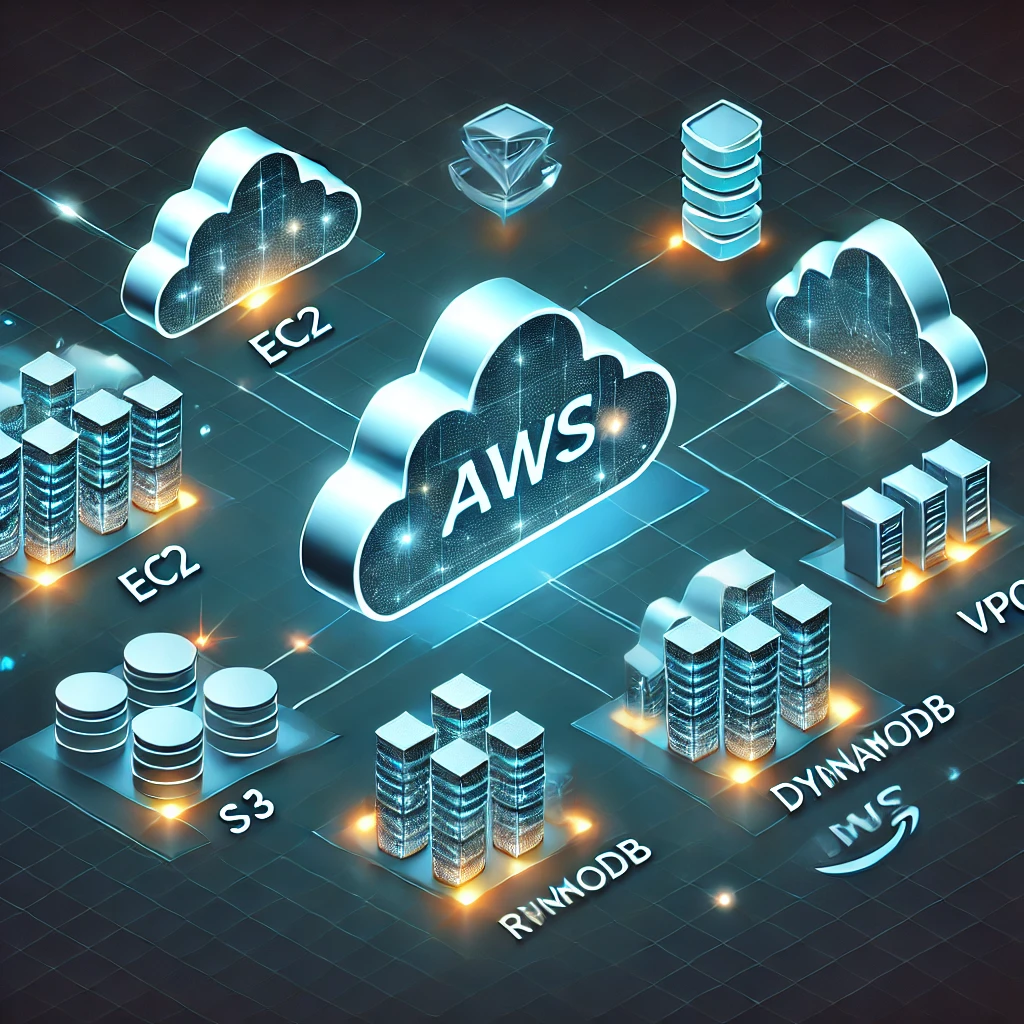Understanding the AWS Cloud Ecosystem
Unveiling the Enigma: A Deep Dive into AWS :-
Understanding the AWS Cloud Ecosystem
Core AWS Services: Compute, Storage, and Databases
- At the heart of AWS lies a triumvirate of fundamental services: compute, storage, and databases. Amazon EC2 (Elastic Compute Cloud) provides scalable virtual servers, allowing you to deploy applications with unparalleled flexibility. Imagine effortlessly scaling your server capacity based on real-time demand – no more worrying about over-provisioning or running out of resources! For storage, AWS S3 (Simple Storage Service) offers durable and cost-effective object storage, perfect for backing up data, storing website assets, or creating data lakes. Need relational or NoSQL databases? AWS has you covered with solutions like Amazon RDS (Relational Database Service) and Amazon DynamoDB, providing highly available and scalable databases for any workload. The sheer power and flexibility of these services are awe-inspiring.
- Consider this: a small startup can begin with a handful of EC2 instances and scale to thousands as their user base explodes, all without major infrastructure headaches. The pay-as-you-go model allows for incredible cost optimization, a boon for businesses of all sizes. This paradigm shift in how we approach computing is truly revolutionary. Think of the seamless scalability offered by AWS. A small e-commerce website can start with a single server, and during peak sales seasons, it can seamlessly scale up to hundreds of servers to handle the traffic increase. This dynamic scalability ensures a smooth and uninterrupted customer experience. This scalability is not just about handling traffic surges, it also makes it cost-effective. Businesses only pay for the resources they actually use.
Networking and Content Delivery within AWS :-
- AWS provides a sophisticated network infrastructure that connects all its services, enabling seamless communication and data transfer. Amazon VPC (Virtual Private Cloud) allows you to create isolated networks within the AWS cloud, providing enhanced security and control over your resources. Amazon Route 53, a highly available and scalable DNS web service, ensures that your applications are always reachable. For fast content delivery, Amazon CloudFront acts as a content delivery network (CDN), caching content closer to users worldwide, significantly improving performance and reducing latency. This global reach and robust infrastructure are crucial for building truly scalable and high-performance applications.
- Imagine a global e-commerce company using CloudFront to distribute their product images and videos. With CloudFront's CDN, these assets are cached in data centers across the globe, ensuring that customers in different regions experience blazing-fast loading times. This significantly improves user experience, leading to higher customer satisfaction and increased conversions. This optimization extends beyond just improving page loading speeds, it also reduces the load on the company's origin servers, resulting in significant cost savings.
Security, Identity, and Compliance in the AWS Cloud :-
- Security is paramount in the cloud, and AWS offers a comprehensive suite of security services to protect your data and applications. IAM (Identity and Access Management) allows granular control over access to your resources, ensuring that only authorized users can access sensitive information. AWS offers a variety of security tools and services, including encryption, intrusion detection, and vulnerability management. Furthermore, AWS adheres to numerous industry compliance standards and regulations, providing a robust and secure environment for your sensitive data. The security features are constantly being updated to adapt to the evolving threat landscape. This proactive security approach is paramount for businesses to maintain the confidentiality, integrity, and availability of their data.
- Consider a healthcare provider storing patient data on AWS. With IAM, they can define strict access control policies, ensuring only authorized medical professionals can access sensitive patient information. AWS's compliance with HIPAA regulations further assures the protection of patient privacy. This rigorous security approach provides a high level of confidence for both the healthcare provider and their patients. This security is not just about technical solutions, it also encompasses robust operational procedures and ongoing compliance monitoring.
Navigating the AWS Service Landscape :-
Choosing the Right AWS Services for Your Needs
- With a vast array of services, selecting the right ones for your specific needs can seem daunting. A thorough understanding of your application's requirements, scalability needs, and budget constraints is crucial. AWS provides extensive documentation and resources to help you navigate this landscape. Start by identifying the core functionalities of your application and then explore the AWS services that best address those needs. Consider factors like performance, cost, and security when making your choices. Remember to leverage the AWS Well-Architected Framework to guide your design decisions. This is a crucial step in ensuring successful cloud adoption.
- For example, a small business building a simple website might choose to use Amazon S3 for storage, Amazon EC2 for compute, and Amazon Route 53 for DNS. A larger enterprise with complex applications might require a more sophisticated architecture using services like Amazon ECS (Elastic Container Service), Amazon EKS (Elastic Kubernetes Service), and various database services. The choice depends on factors like the complexity of the application, the level of scalability required, and the budget constraints. It's important to understand that the architecture you choose should be scalable, reliable, and cost-effective.
- Understanding AWS Pricing Models and Cost Optimization
- AWS employs a pay-as-you-go pricing model, meaning you only pay for the resources you consume. However, understanding the nuances of this pricing model is crucial for cost optimization. AWS provides detailed pricing information and tools to help you manage your costs. Utilize features like AWS Cost Explorer to monitor your spending and identify areas for potential savings. Implement cost optimization strategies like right-sizing your instances, using reserved instances, and leveraging spot instances. Proactive cost management can significantly reduce your cloud spending without compromising performance.
- For example, using Reserved Instances can significantly reduce costs compared to on-demand instances. This is particularly beneficial for applications with predictable workloads. Similarly, Spot Instances offer significant discounts for applications that can tolerate interruptions. These cost-saving strategies are crucial for managing cloud costs effectively. Effective cost management involves regular monitoring, optimization, and a comprehensive understanding of AWS pricing models. It is not just about reducing costs, but also ensuring that the right resources are available to support the business needs.
Leveraging AWS Management Tools and Best Practices :-
- AWS offers a robust set of management tools to simplify the administration and operation of your cloud infrastructure. AWS CloudFormation allows you to automate the provisioning and management of your AWS resources, while AWS OpsWorks helps you manage your servers and applications. Utilize AWS Systems Manager for centralized management and automation of your infrastructure. Embrace best practices such as using version control, implementing automation, and monitoring your resources regularly. Following these best practices helps ensure the reliability, security, and cost-effectiveness of your cloud deployment.
- Consider using AWS CloudFormation templates to automate the deployment of your infrastructure. This ensures consistency and repeatability across different environments. This automation reduces the risk of manual errors and allows for faster deployment times. Automation also ensures scalability and allows for consistent deployments across different environments, ensuring consistent performance and scalability. Proper monitoring and management are crucial to ensuring high availability and a reliable system.
Real-World Applications of AWS :-
AWS for Web Applications and E-commerce
- AWS powers countless web applications and e-commerce platforms, offering the scalability, reliability, and performance needed for success. From small startups to large enterprises, businesses rely on AWS to handle their web traffic and data storage. The flexibility of AWS allows businesses to easily scale their web applications as their user base grows, ensuring a seamless user experience. AWS also provides a robust set of tools and services for building and deploying web applications quickly and efficiently.
- Imagine a rapidly growing e-commerce platform using AWS to handle its massive traffic spikes during peak shopping seasons. With AWS's scalable infrastructure, the platform can easily handle these surges in traffic without compromising performance. This ensures a seamless shopping experience for customers, leading to increased sales and customer satisfaction. This flexibility and scalability make AWS an ideal platform for businesses of all sizes.
AWS for Big Data Analytics and Machine Learning :-
- AWS provides a comprehensive suite of services for big data analytics and machine learning, enabling businesses to extract valuable insights from their data. Amazon EMR (Elastic MapReduce) allows you to easily process and analyze large datasets, while Amazon SageMaker provides a platform for building, training, and deploying machine learning models. AWS's vast computing power and scalability make it ideal for handling the massive datasets required for advanced analytics and machine learning. The tools and services are designed to make big data processing and machine learning more accessible.
- Consider a large financial institution using AWS to analyze customer transaction data to detect fraudulent activity. With AWS's big data and machine learning services, the institution can build sophisticated models to identify suspicious transactions in real time, minimizing losses and protecting its customers. This ability to process and analyze vast amounts of data is crucial in the fight against financial fraud. AWS provides the infrastructure and tools necessary for such advanced analytics.
AWS for Mobile Applications and IoT :-
- AWS is a powerful platform for building and deploying mobile applications and IoT (Internet of Things) solutions. AWS Amplify provides a comprehensive framework for building mobile applications, while AWS IoT Core allows you to securely connect and manage your IoT devices. The scalability and reliability of AWS make it suitable for handling the massive volume of data generated by mobile applications and IoT devices. AWS offers a robust set of tools and services for building and deploying mobile apps and IoT solutions.
- Imagine a smart home system using AWS IoT Core to connect and manage various devices such as smart lights, thermostats, and security systems. With AWS IoT Core, the system can securely connect these devices, enabling users to control them remotely through a mobile application. This provides convenience and improved security for the users. AWS provides the necessary infrastructure and tools to manage and secure such complex interconnected systems.
AWS for DevOps and Automation :-
- AWS provides a comprehensive set of tools and services for implementing DevOps practices and automating your infrastructure management. AWS CodePipeline allows you to automate your software release pipeline, while AWS CodeDeploy helps you deploy your applications to various environments. AWS CloudFormation allows you to automate the provisioning and management of your AWS resources. Utilizing these tools and services can significantly improve the efficiency and reliability of your software development and deployment processes. AWS promotes a culture of continuous integration and continuous deployment (CI/CD).
- Consider a software development team using AWS CodePipeline to automate their software release process. With CodePipeline, they can automatically build, test, and deploy their software whenever changes are made to the code repository. This automation significantly reduces the time required to release new software versions, allowing for faster innovation and quicker responses to customer feedback. This streamlining of the software release process is essential for maintaining a competitive edge in today's fast-paced software market.
The Future of AWS and Cloud Computing :-
Emerging Trends in Cloud Technology
- The cloud computing landscape is constantly evolving, with new technologies and trends emerging regularly. Serverless computing, edge computing, and AI/ML are just a few of the significant advancements shaping the future of cloud technology. Staying abreast of these developments is crucial for businesses to leverage the latest innovations and remain competitive. Continuous learning and adaptation are essential in the dynamic world of cloud computing.
- Serverless computing, for example, offers a paradigm shift in how applications are built and deployed. It allows developers to focus on their code without worrying about server management. This leads to increased efficiency and reduced operational overhead. Edge computing is another important trend, bringing computing closer to data sources, improving latency and bandwidth. These trends continue to redefine the possibilities of cloud computing.
The Role of AWS in Digital Transformation :-
- AWS plays a pivotal role in enabling digital transformation for businesses of all sizes. By providing the infrastructure and tools necessary for innovation, AWS empowers businesses to modernize their operations, improve efficiency, and create new revenue streams. The scalability and flexibility of AWS allow businesses to quickly adapt to changing market demands and leverage new technologies. This adaptability is crucial for success in today's rapidly evolving digital landscape.
- Many companies are using AWS to migrate their on-premises applications to the cloud. This migration process can significantly reduce operational costs and improve efficiency. It also allows businesses to scale their applications more easily and respond quickly to changes in demand. Furthermore, AWS allows businesses to leverage new technologies such as AI and machine learning to gain a competitive edge.
Challenges and Opportunities in the Cloud Landscape :-
- While the cloud offers many advantages, it also presents challenges such as security concerns, vendor lock-in, and the need for skilled personnel. However, these challenges are often outweighed by the opportunities presented by the cloud's scalability, cost-effectiveness, and innovation potential. Businesses must carefully plan and execute their cloud strategies to mitigate risks and maximize the benefits. Proactive planning and a strategic approach are crucial for successful cloud adoption.
- Security is paramount when using cloud services. Businesses must implement robust security measures to protect their data and applications. Vendor lock-in is another potential challenge, so businesses must choose cloud providers and solutions carefully to avoid being tied to a specific vendor. Despite these challenges, the opportunities presented by cloud computing are vast, ranging from increased efficiency and cost savings to the ability to leverage new technologies and innovate more quickly. Careful planning and a well-defined strategy are crucial for navigating these challenges and capitalizing on these opportunities.
Review
Kalpesh Shewale
I am grateful to have completed my Full Stack Development with AI course at Apnaguru. The faculty's support and interactive classes helped me discover my potential and shape a positive future. Their guidance led to my successful placement, and I highly recommend this institute.
Kalpesh Shewale
I am grateful to have completed the Full Stack Development with AI course at Apnaguru. The faculty's dedicated support and hands-on approach during the classes enabled me to unlock my potential and shape a promising future. Their guidance helped me secure a placement with a good package. I highly recommend this course, and for those interested, I also suggest doing the offline version at the center for an enhanced learning experience.

Raveesh Rajput
Completing the Full Stack Development with AI course at Apnaguru was a game-changer for me. I secured an internship through this course, which gave me invaluable hands-on experience. I strongly recommend this course to anyone looking to break into the tech industry. For the best experience, I suggest attending the offline sessions at the center, where the interactive learning environment really enhances the overall experience.

swapnil shinde
Apnaguru’s Full Stack Development with AI course provided me with more than just knowledge—it opened doors to an internship that gave me real-world, hands-on experience. If you're serious about a career in tech, this course is a must. I highly recommend attending the offline sessions for the most immersive and interactive learning experience!
Kalpana Waghmare
I recently completed the Full Stack Developer with AI course on ApnaGuru, and I couldn’t be more impressed! The structure of the course, with well-organized topics and self-assessment MCQs after each section, really helped reinforce my learning. The assignments were particularly valuable, allowing me to apply what I learned in a practical way. Overall, it’s an excellent program that effectively combines full-stack development and AI concepts. Highly recommended for anyone looking to enhance their skills!
Completing the Full Stack Development with AI course at Apnaguru was a pivotal moment in my career. It not only deepened my understanding of cutting-edge technologies but also directly led to an internship that provided practical, real-world experience. If you're aiming to enter the tech field, this course is an excellent stepping stone. I especially recommend attending the in-person sessions at the center, where the dynamic, hands-on learning approach truly maximizes the benefits of the program.

Mahesh Bhosle
I completed the Full Stack Development course at Apnaguru, and it was a valuable experience. The focus on live assignments and projects gave me real-world insights, helping me apply my skills in a professional setting. The interactive live sessions, mock interviews, and question banks were excellent for job preparation. Apnaguru’s company-like environment also helped me get accustomed to real work dynamics. Overall, this course equipped me with the skills and confidence needed for a career in full-stack development. I highly recommend it to anyone seeking hands-on learning and industry relevance.
I recently completed the Full Stack course at ApnaGuru, and I’m genuinely impressed! The curriculum is well-structured, covering both front-end and back-end technologies comprehensively. The instructors are knowledgeable and provide hands-on experience through practical projects. The supportive community and resources available made learning enjoyable and engaging. Overall, it’s a great choice for anyone looking to kickstart a career in web development. Highly recommend!

Adarsh Ovhal
I recently participated in the Full Stack Development With AI Course program, and it has been incredibly beneficial. The guidance I received was tailored to my individual needs, thanks to their advanced use of AI tools. The Trainers were knowledgeable and supportive, helping me explore various educational and career paths. The resources and workshops provided were practical and insightful, making my decision-making process much clearer. Overall, I highly recommend this program to any student looking for IT Field and personalized career guidance!
Shirish Panchal
I’m currently pursuing the Full Stack Developer with AI course at ApnaGuru Training Center, and I'm impressed with what I've experienced so far. The curriculum is well-structured, covering key concepts in both front-end and back-end development, along with AI fundamentals. The instructors are knowledgeable and supportive, which makes it easy to engage and ask questions. I particularly appreciate the hands-on projects that help reinforce what I’m learning. While I’m still in the process of completing the course, I feel that I'm building a strong foundation for my future in tech. I would recommend ApnaGuru to anyone looking to explore full stack development with AI!
Apnaguru Training Center stands out as a top-notch institute for IT education. They provide a wide array of courses, including Full Stack Development, Java Full Stack, Python, Automation Testing, DevOps, and MERN/MEAN Stack, all designed to meet the demands of the modern tech industry.

Mahesh Bhosle
Apnaguru Training Center is a fantastic place for IT education! They offer a variety of courses, including Full Stack Development, Java Full Stack, and Python, all taught by knowledgeable instructors who are committed to student success. The curriculum is up-to-date and includes hands-on projects that enhance learning.
dandewar srikanth
I had an excellent experience with the full-stack web development program at APNAGURU. The instructor had in-depth knowledge of both frontend and backend technologies, which made the concepts easy to grasp. From working on HTML, CSS, JavaScript, and React for the frontend to Node.js and MongoDB for the backend, the learning curve was very smooth.
